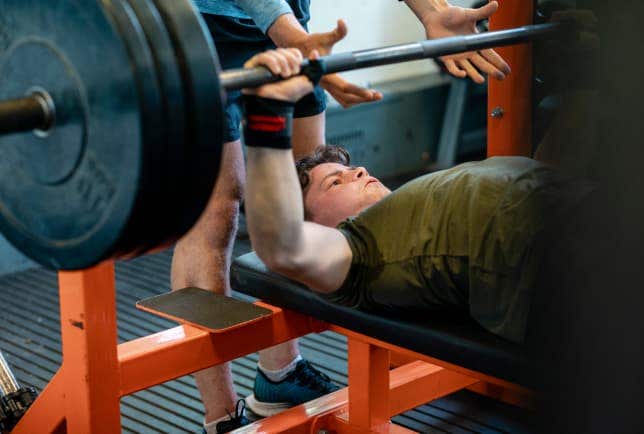
One rep (1rm) CALCULATOR
One Rep calculator
Want to know the heaviest weight you can lift for just one go? That's your one rep max (1RM) – the peak weight you can handle for a single lift, be it a squat, bench press, deadlift, or any other exercise. For safety and effectiveness, using a one rep max calculator can give you a solid idea of what weights you should be attempting.
Your 1RM is also pivotal if you're following the Maximal Strength phase of the NASM OPT™ Model. Here, you'll typically be lifting at 85-100% of your 1RM, so knowing your limits ensures your workouts remain challenging yet safe. After plugging in your lift numbers, you'll see a breakdown that shows where you stand with your max lifts. And, don't make the mistake of thinking your max on one lift applies to another – your bench press 1RM might be worlds apart from your back squat.
Keep in mind, these figures are ballpark estimates. If you're unsure, chatting with a personal trainer can offer some clarity (or start the journey of becoming a coach yourself).
Psst.. check out our other tools like the BMI Calculator and Calorie Calculator can offer more insights into your fitness journey.
<li> <p>Row 1</p>
<ul>
<li>Experience Level</li>
<li>Deadlift (kg)</li>
<li>Bench Press (kg)</li>
<li>Squat (kg)</li>
</ul>
</li>
<li> <p>Row 2</p>
<ul>
<li>Beginner</li>
<li>60–100</li>
<li>40–70</li>
<li>50–85</li>
</ul>
</li>
<li> <p>Row 3</p>
<ul>
<li>Intermediate</li>
<li>100–140</li>
<li>70–100</li>
<li>85–125</li>
</ul>
</li>
<li> <p>Row 4</p>
<ul>
<li>Advanced</li>
<li>140–180</li>
<li>100–130</li>
<li>125–170</li>
</ul>
</li>
<li> <p>Row 5</p>
<ul>
<li>Elite</li>
<li>180+</li>
<li>130+</li>
<li>170+</li>
</ul>
</li>
</ul>
Standard 1RM table
Please note that "standard" 1RM values can differ based on age, gender, weight, training history, and other factors. Below is a generalized range for an average adult male, assuming he's in decent shape but not necessarily an elite athlete.

Always consult with a fitness professional to set realistic and safe goals.

How to calculate one rep max (without a calculator)
Calculating your one rep max (1RM), the maximum weight you can lift for a single repetition, can be done using several methods. However, it's safer and more common to estimate the 1RM using submaximal loads (lifting lighter weights for more reps) rather than testing it directly.
Here's a widely-used formula to estimate 1RM:
1RM = (Weight Lifted×Repetitions Performed / 30.48) + Weight Lifted
Steps to calculate 1RM:
1. Choose a weight that you can lift for a known number of repetitions (e.g., 5 reps, 8 reps, etc., but usually not more than 10 to maintain accuracy).
2. Perform the lift, noting the maximum number of repetitions you can do with good form.
3. Plug the weight and repetitions into the formula to estimate your 1RM.
For example, if you can squat 100kg for 8 reps:
1RM = (100×8 / 30.48) + 100
1RM ≈ 126.3kg
So, the estimated 1RM for the squat is roughly 126.3kg.
It's important to remember that this formula provides an estimate. The actual 1RM might be slightly different. Always prioritize safety, and consider consulting with a fitness professional before attempting maximal lifts or if you're new to strength training.

How to increase your bench press max
The bench press stands out as a top exercise for cultivating power and building a strong chest. If you're keen on tracking your progress with a one rep max calculator, here are some strategies to enhance your bench.
It's important to note, though, that these methods best serve experienced lifters. Always ensure you're lifting in a safe environment and with the correct technique.
1. Prioritize proper form:
According to Kinsey Mahaffey's insights on improving the bench press:
- Start by lying flat with a neutral spine, feet flat and pointing forward.
- Grip the barbell at about 1.5 to 2 times your shoulder width, ensuring your hands are evenly placed.
- Engage your core and pin your shoulder blades back.
- With the help of a spotter, if possible, unrack the bar so it's directly above your shoulders.
- Control the bar's descent towards your mid to lower chest.
- As you press up, engage your core and glutes, exhaling as you return to the starting position.
2. Adjust weight and reps:
For optimal results in increasing your bench press max, work within the 85-100% range of your one rep max, focusing on 1-5 reps. This approach demands lifting at or near your max to achieve those gains.


3. Experiment with set variations:
While many are familiar with straight sets or horizontal loading, trying alternatives like pyramid sets can be a game-changer. In a pyramid set, you elevate the weight with each successive set, reducing reps as the weight goes up.
4. Strengthen supportive muscles:
The bench press isn't just about the chest. Enhance your overall strength by training those supporting muscles like the anterior deltoids, triceps, and rotator cuffs. These muscles play a crucial role in your bench press performance, so don't skimp on them.
Explore our other calculators



